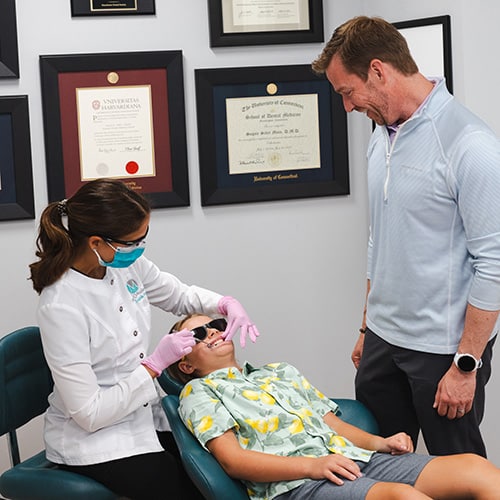When it comes to your child’s smile, timing matters. The American Association of Orthodontists recommends that children have their first orthodontic evaluation by age 7.
At this stage, your child has a mix of baby and permanent teeth, allowing Dr. Sogole Moin to identify developing concerns early and determine whether treatment is needed now or simply monitored over time. Some children may even be referred earlier if their dentist notices issues with jaw growth, dental eruption, or bite development.
Why Should My Child See an Orthodontist Early?
Early orthodontic evaluations help identify small problems before they become more serious. An early assessment can:
- Guide erupting teeth into better positions
- Create space for permanent teeth to come in correctly
- Reduce the risk of injury to protruding front teeth
- Address jaw growth concerns while the bones are still developing
- Help manage habits like thumb-sucking or address certain speech issues
Many bite issues, such as crowding, deep bites, crossbites, or underbites, are more efficiently corrected while a child is still growing. Early orthodontic treatment focuses on guiding jaw development and tooth eruption, which can reduce the need for more extensive treatment later.
What Happens at an Early Orthodontic Evaluation?
During your child’s first orthodontic visit, Dr. Moin will:
- Review dental and medical history
- Evaluate the teeth, bite, and jaw alignment
- Take any necessary photos or X-rays to assess tooth development
- Discuss whether treatment should begin now, later, or not at all
By the end of the visit, you’ll have a clear understanding of your child’s needs and the ideal timing for treatment.
What Can Early Orthodontic Treatment Accomplish?
If early intervention, often called Phase I treatment, is recommended, it may:
- Improve how the upper and lower jaws fit together
- Expand narrow dental arches
- Create proper space for incoming permanent teeth
- Reduce the need for future extractions
- Prevent teeth from becoming severely displaced or impacted
- Improve chewing, breathing, and oral function
Treatments used during this phase are gentle, effective, and designed with your child’s comfort in mind.
Will Early Orthodontic Treatment Prevent Braces Later?
Not always, but it often makes later treatment simpler, shorter, and more predictable. Early treatment focuses on correcting foundational growth and bite issues while your child is young. Later, once all permanent teeth are present, a shorter Phase II treatment with full braces or Invisalign may be recommended to fine-tune the alignment.
Some children need only early treatment and no braces as teens, while others benefit from both phases. Every smile is unique.
Does Every Child Need Early Orthodontic Treatment?
No. Many children are best treated once most permanent teeth have erupted. Some concerns are actually more effective to correct during the teenage years.
If immediate treatment is not recommended, your child will be placed in our Orthodontic Observation Program, which provides:
- Regular check-ins every 6 to 12 months
- Monitoring of tooth eruption and jaw growth
- Recommendations for timely interventions when needed
- Communication with your child’s dentist to coordinate care
This no-cost program ensures treatment begins at exactly the right time.
What Is Two-Phase Orthodontic Treatment?
Two-phase treatment is a structured approach that uses your child’s natural growth to achieve the best long-term results.
- Phase I (Developmental Phase): Focuses on guiding jaw growth, improving bite function, and addressing major early concerns before all permanent teeth erupt.
- Resting Period: We pause active treatment and continue monitoring growth and eruption.
- Phase II (Comprehensive Phase): Once all permanent teeth are in, braces or clear aligners are used to perfectly position every tooth for a healthy, stable smile.
Benefits of Early Orthodontics
Early orthodontic care can:
- Improve bite function and chewing efficiency
- Enhance long-term oral health by reducing crowding
- Reduce uneven wear on teeth
- Support balanced facial development
- Boost confidence by improving your child’s smile early in life
These benefits extend well into adulthood.
Do Children Still Need to See Their Dentist?
Yes. Your child should continue visiting their dentist every six months. Regular cleanings and exams are essential, especially when orthodontic appliances make brushing and flossing more challenging.
Frequently Asked Questions
Have more questions about early orthodontic treatment? Here are some of the most common things parents want to know.
What Are the Signs That My Child May Need Early Orthodontic Care?
Crowding, early or late loss of baby teeth, difficulty chewing, thumb-sucking habits, crossbites, underbites, or teeth that stick out may indicate a need for early evaluation.
How Will Early Treatment Affect My Child’s Daily Routine?
Most children adapt quickly. They can attend school, participate in sports, and continue normal activities with little to no interruption.
Are Early Orthodontic Appliances Hard for Children to Keep Clean?
Some appliances require extra care, but our team teaches children and parents how to brush, floss, and maintain excellent oral hygiene throughout treatment.
How Often Will My Child Need Appointments During Early Treatment?
Typically every 6 to 10 weeks, depending on the appliance and treatment plan.
What Happens If We Choose to Wait Instead of Starting Early Treatment?
In some cases, delaying treatment may lead to more complex issues, permanent tooth impaction, or the need for extractions or surgery later. Dr. Moin will guide you on the safest and most effective timing.

